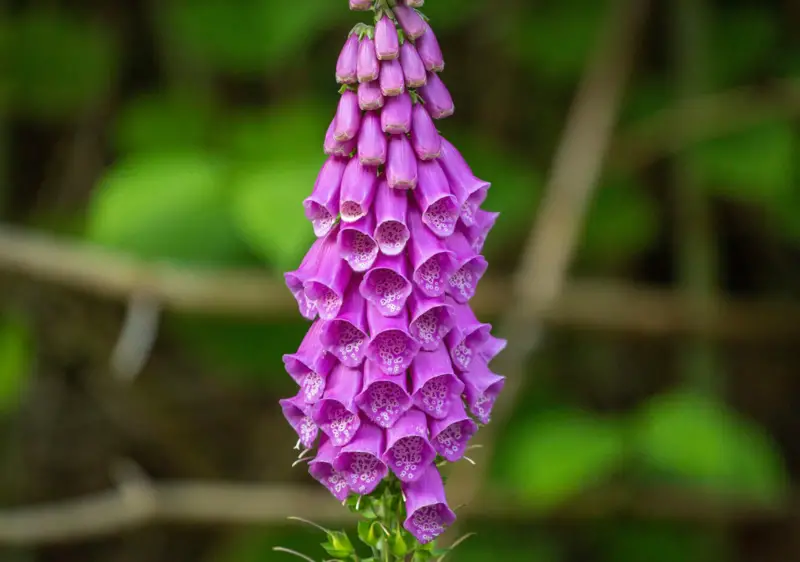
Are you looking to attract more of those delightful, tiny acrobats we call hummingbirds to your outdoor space? Well, I’ve got just the flower for you – the tall, elegant, and absolutely stunning foxglove!
Why Hummingbirds Can’t Resist Foxgloves
Foxgloves (Digitalis spp.) are like nature’s perfect hummingbird feeders. These towering beauties produce long spikes covered in tubular flowers that seem custom-made for a hummingbird’s long, slender beak. The shape of foxglove blooms allows hummingbirds to hover and sip nectar with ease, making them irresistible to these tiny flying jewels. But it’s not just the flower shape that attracts hummingbirds. Foxgloves come in a range of colors that catch a hummingbird’s eye, including:
- Deep purples
- Soft pinks
- Crisp whites
- Warm yellows
While hummingbirds are particularly drawn to red flowers, they’ll happily visit foxgloves of any hue. The speckled interiors of many foxglove varieties add an extra visual pop that seems to intrigue these curious little birds.
Foxgloves: A Cottage Garden Classic

Beyond their hummingbird-attracting superpowers, foxgloves are a beloved staple of cottage gardens. Their tall, dramatic flower spikes add vertical interest and a touch of whimsy to any garden setting.
Foxgloves typically grow 2-5 feet tall, with some varieties reaching even greater heights. These eye-catching plants bloom in late spring to early summer, providing a much-needed nectar source for hummingbirds just as they’re establishing their territories for the season.
A mass planting of foxgloves can create a stunning visual display while also serving as a hummingbird buffet!
Growing Foxgloves: Easier Than You Might Think
Now, I know what some of you might be thinking – “Aren’t foxgloves difficult to grow?” The good news is that these beautiful plants are actually quite easy to cultivate, even for beginner gardeners. Here’s what you need to know:
Sun and Soil Requirements
Foxgloves are adaptable plants that can thrive in a range of light conditions. In general, they prefer:
- Partial shade to full sun (depending on your climate)
- Rich, well-draining soil
- Slightly acidic soil (pH 5.5 to 6.5)
In hotter regions, providing some afternoon shade can help keep your foxgloves happy and blooming longer.

Planting and Care
To get started with foxgloves:
- Plant in spring or fall, spacing plants about 2 feet apart.
- Water regularly, especially during dry spells.
- Add a layer of organic mulch to retain moisture and suppress weeds.
- Stake taller varieties to prevent them from flopping over in windy conditions.
Foxgloves are generally low-maintenance once established. They don’t require much fertilizer – in fact, too much nitrogen can lead to fewer flowers.
Biennial vs. Perennial Foxgloves
It’s important to note that many common foxglove varieties, including the popular Digitalis purpurea, are biennial. This means they grow leaves in their first year and flower in their second year before setting seed and dying. However, foxgloves are prolific self-seeders, so you’ll often have new plants popping up each year.
For continuous blooms without relying on self-seeding, consider planting some perennial foxglove varieties like Digitalis grandiflora (yellow foxglove) or Digitalis mertonensis (strawberry foxglove). These will return year after year, providing a reliable nectar source for your hummingbird visitors.

Creating a Hummingbird Haven with Foxgloves
To maximize the hummingbird-attracting potential of your foxgloves, consider these tips:
- Plant in groups: Hummingbirds are more likely to notice and visit larger plantings.
- Combine with other hummingbird favorites: Pair foxgloves with other nectar-rich flowers like salvias, bee balm, and cardinal flower for a diverse buffet.
- Provide perches: Hummingbirds like to rest between feeding sessions. Leave some bare branches or add slender stakes near your foxgloves for convenient perching spots.
- Avoid pesticides: Hummingbirds also eat small insects for protein. Keep your garden chemical-free to ensure a healthy ecosystem.
- Add a water source: A small fountain or mister near your foxgloves can attract hummingbirds and provide them with a place to bathe and drink.
A Word of Caution
While foxgloves are beautiful and beneficial for wildlife, it’s crucial to remember that all parts of the plant are toxic if ingested. Always wear gloves when handling foxgloves and keep them away from children and pets. The toxicity that makes them dangerous to humans is precisely what protects them from being eaten by deer and rabbits, making them a great choice for gardens in areas with high deer populations.
Foxglove Varieties to Try
Ready to add some foxgloves to your garden? Here are a few varieties to consider:
- ‘Camelot Mix’: A first-year flowering variety with a range of pink, white, and purple blooms.
- ‘Foxy’: Another first-year bloomer with a compact growth habit, perfect for smaller gardens.
- ‘Excelsior Hybrids’: Tall plants with flowers that encircle the entire stem, available in pastel shades.
- ‘Pam’s Choice’: White flowers with dramatic maroon spotting inside.
- ‘Sutton’s Apricot’: Soft peachy-pink blooms that add a unique color to the garden.
Conclusion: A Win-Win for Gardeners and Hummingbirds
Incorporating foxgloves into your garden is a surefire way to attract more hummingbirds while also adding a touch of cottage garden charm. These tall, spikey beauties offer a perfect blend of form and function, providing vital nectar for our tiny feathered friends and visual drama for us humans to enjoy.







